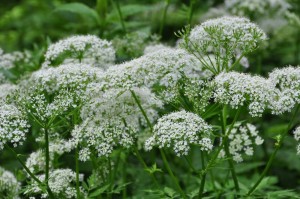 In my part of the world, mid-summer is the time when every country hedgerow, roadside verge and untended space is covered with the blue flowers of wild chicory and the frothy blooms of Queen Anne’s lace. Those distinctive white flowerheads are so vigorous that they may even spring up from wide sidewalk cracks.
In my part of the world, mid-summer is the time when every country hedgerow, roadside verge and untended space is covered with the blue flowers of wild chicory and the frothy blooms of Queen Anne’s lace. Those distinctive white flowerheads are so vigorous that they may even spring up from wide sidewalk cracks.
I love them both, but have a special fondness for Queen Anne’s lace, known botanically as Daucus carota, and commonly as “wild carrot.” Like so many plants and animals that we regard as native, it actually hails from Europe and parts of Asia. Once early settlers brought Queen Anne’s lace across the Atlantic, it escaped from gardens and put down roots wherever it found space and even semi-hospitable conditions. Now it is ubiquitous in many places and considered a “noxious weed” in 35 American states.
Several years ago, I read a great article by celebrated English horticulturist, Val Bourne. Writing in the Telegraph newspaper, Bourne described the “Top 10 Best Cow Parsleys for Pollinators”. Most Americans would find this title confusing, because we do not generally use the term “cow parsley.” The bovine name derives from the fact that “cow parsleys” are field plants commonly found growing around the edges of farm fields making them easy fodder for hungry cows. They are members of the Umbelliferae or carrot family, and our very own “American” Queen Anne’s lace, is probably the best known umbellifer.
The family name “Umbelliferae” comes from the Latin root, “umbra,” meaning “shade.” It also gave rise to words like “umbrella,” a device that shades us from the elements, not to mention the color “umber” a shady shade of brown. “Umbelliferae” is very descriptive, as the flowers of some species, including Queen Anne’s lace, fennel; angelica and plain old carrots or Daucus carota sativus, look like upside down umbrellas when they are viewed from the underside or have gone to seed.
Umbelliferae, though descriptive, did not prove descriptive enough for plant taxonomists, who make it their business to classify the world’s flora according to common characteristics. The taxonomists clearly thought the umbrella-like name was inadequate, so the rechristened the family “Apiaceae.” This name, while less evocative, is also descriptive, derived from the Latin root “apis,” meaning bee. The same root gave us the word “apiary,” an elegant term for a beehive. With flowers full of nectar, the former umbellifers are magnets for bees and many other pollinators.
Which brings us back to cow parsley. If you are planning a garden for pollinators, members the Apiaceae family are excellent choices, but you may not want to choose something as rampant as Queen Anne’s lace. The most popular ornamental carrot family member–in this country at least–is astrantia, sometimes called “masterwort.” Astrantia feature long-lasting 1.5-inch flowerheads in varying shades of pink or greenish white. Each flower boasts a central umbel of tiny florets surrounded by a corona of daisy-like petals. The sun-loving plants rise 18 to 24 inches, with and 18 inch spread and flower stems that are nearly leafless, because all the palmate leaves are mounded at the base. Masterwort prefers consistently moist soil and long, cool summers, but some hybrids do nicely in less congenial situations if they receive enough regular moisture. Happy plants spread by underground stolons and some varieties self-seed. One popular cultivar, ‘Roma,’ boasts silvery pink flowers and a civilized habit that does not generally lead to unwanted offspring. The flowerheads also make excellent dried specimens.
Another pollinator-friendly cow parsley looks more like a thistle than an umbrella. It is Eryngium or sea holly. The most popular varieties sport blueish compound flower heads that are rather conical in shape. Each is surrounded by a ring of green, spiky-looking bracts. As with masterwort, sea holly features basal leaves that are palmately divided. Unlike masterwort, sea holly can grow up to three feet tall. Fortunately for small-space and container gardeners, compact varieties, like Eryngium planum ‘Blue Hobbit,’ grow only 12 inches tall.
For a pollinator-friendly umbellifer that actually flaunts those umbrella-like characteristics, try Ammi majus, sometimes known as bishop’s flower or “false Queen Anne’s lace.” As the name suggests, Ammi is a more civilized, less invasive substitute for its look-alike cousin. It grows up to four feet tall, making the plants most suitable for the middle of a large border or the rear of a small one. The foliage is typically fern-like and the compound flowerheads are full of white or greenish-white blooms. If you can steal Ammi blooms away from the bees, they, like many cow parsleys, make great cut flowers.
In the last few decades, many of us have come to value the role that bees and other pollinators play in the fragile ecosystem. By inviting a few umbellifers into the garden, we can do our bit to protect and encourage them.
